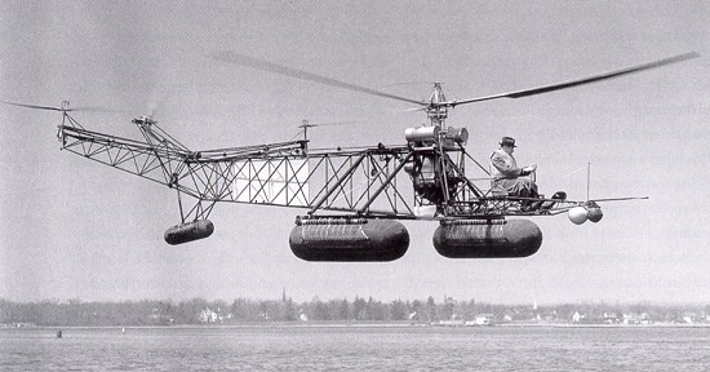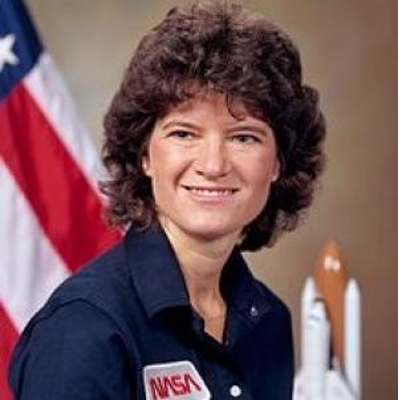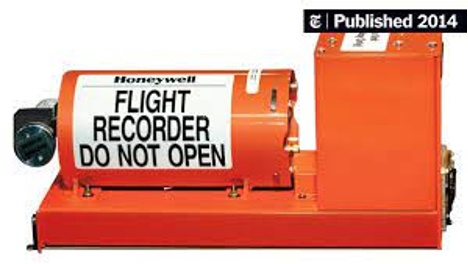I have chosen the Vought-Sikorsky VS-300 helicopter, Dr. Sally Ride, and Black Box technology as the most important in aviation history. The VS-300 helicopter paved the way for the modern helicopter, which has been significant in air transport. Unlike other airplanes, the helicopter does not necessarily need an airport to land or take off. As the first American woman in space, Dr. Sally Ride made history and contributed significantly to space research and the aviation industry. Finally, the development of the black box flight recorder has transformed aviation safety and how accidents involving planes are investigated.
MOST IMPORTANT AIRCRAFT
I chose the Vought-Sikorsky VS-300 helicopter as the most crucial aircraft because it was the first helicopter to be assembled and the first to demonstrate that a single main rotor and single tail rotor design could be a stable and controllable helicopter. It was created by Igor Sikorsky and was the first single main rotor and single tail rotor helicopter, and it paved the path for creating the modern helicopter. The VS-300 was the first to show that a helicopter was feasible. The Vought-Sikorsky VS-300 prototype helicopter made its first tethered flight on September 14, 1939, lasting only 10 seconds but proving that the helicopter could be developed (Swopes, 2022). After being tested for 102 hours, 32 minutes, and 26 seconds, the VS-300 was given to the Henry Ford Museum.
The VS-300’s airframe was made of welded tubular steel, and its main rotor had a diameter of 28 feet (5.34 meters), was utterly articulated, and rotated at 260 revolutions per minute (rpm). Initially powered by a Lycoming O-145C-3 four-cylinder, horizontally opposed, air-cooled, normally aspirated engine with a displacement of 144.489 cubic inches (2.368 liters) rated for 75 horsepower at 3,100 revolutions per minute. Later in the VS-300’s development, a 90-horsepower Franklin 4AC-199 engine replaced the Lycoming. Along with being the first of its sort, the VS-300 also had a tail rotor for anti-torque and yaw control. The tail “propellers” featured two blades, each measuring 7 feet, 8 inches (2.337 meters) in diameter, and rotated at about 1,300 revolutions per minute (rpm) (Swopes, 2022). Nowadays, we refer to these as rotors. The blade pitch and “torque correction” (anti-torque) were reversible thanks to the vertical rotor. On the rear of the fuselage, the horizontal rotors were mounted on 10-foot (3.048-meter) outriggers. One rotor’s pitch was raised for lateral control while the other’s pitch was lowered. The pitch of both rotors was changed simultaneously for longitudinal control.
The VS-300 was also the first to show that an amphibious helicopter—one that could land and take off from both land and water—might be possible. The VS-300’s amphibious capabilities were shown on April 17, 1941, when the helicopter successfully performed a water landing while equipped with three inflatable pontoons. It is impossible to dispute the VS-300’s importance in aviation history. It opened the path for creating the modern helicopter by being the first to demonstrate that a single main rotor and single tail rotor design could be stable and controllable. Its benefits to aviation have been immeasurable, and its ground-breaking tail rotor and amphibious capabilities are now commonplace in helicopters.
MOST IMPORTANT PERSON
I chose Dr. Sally Ride as the most important because of her lasting contributions to space exploration and the aviation business. Dr. Sally Ride was an American physicist, astronaut, and educator. She was the youngest American astronaut at the time and the first American woman to visit space. 1951 saw the birth of Dr. Ride in Encino, California. She loved tennis early on and was nationally recognized as a young player. She received her undergraduate education at Swarthmore College before pursuing her graduate studies at Stanford University. Ride responded to a newspaper ad issued by the National Aeronautics and Space Administration (NASA) in 1977 after receiving her degree in physics (Anderson, 2018). She was one of just five women chosen for the “Thirty-Five New Guys” astronaut class of 1978. She trained with NASA in 1977, using her tremendous natural athletic talent. She was chosen for the first astronaut class to include women in 1978, dubbed the “Thirty-Five New Guys,” which included her.
When Dr. Ride was assigned aboard the space shuttle Challenger for the STS-7 mission in 1983, she made history by being the first American woman to travel into space. She completed the journey, which included several science experiments and the deployment of two communications satellites. On October 5, 1984, Ride made history again when she completed her second space flight, becoming the first American woman to do it. She conducted scientific studies of the Earth, launched the Earth Radiation Budget Satellite, and tested prospective methods for refueling satellites during this mission (Anderson, 2018). Despite being given a third trip, she eventually joined the Rogers Commission, looking into the Challenger catastrophe when it went missing in January 1986.
Notwithstanding her two trips into space, Dr. Ride has contributed to the aviation sector. She accepted a position as a special assistant to the NASA administrator for long-term and strategic planning after serving on the Rogers Commission, which looked into the Challenger catastrophe in 1986. Ride resigned from NASA in 1989 to become the head of the California Space Institute at the University of California, San Diego. He also joined the faculty there as a professor of physics. She then became the California Space Institute’s director and physics professor at the University of California. She started Sally Ride Science, a business that inspired young girls and women to work in science, technology, engineering, and math when she left NASA (Anderson, 2018). Throughout her career, Ride won a great deal of recognition and accolades. She was honored with numerous awards, including the Theodore Roosevelt Award from the NCAA, the Jefferson Award for Public Service, the von Braun Award, the Lindbergh Eagle, and induction into the National Women’s Hall of Fame and the Astronaut Hall of Fame. Ride transformed the look of the American space program while breaking down barriers with style and expertise. Generations of women have been motivated by her to work in technology, math, and science.
The influence of Dr. Ride on the aviation sector cannot be disputed. In addition to her ground-breaking accomplishments, she inspired many people with her poise and professionalism. She served as an inspiration for hundreds of women, inspiring them to follow their passions and overcome obstacles. She was dedicated to encouraging the subsequent generation of scientists and astronauts and ensured that young girls and women had access to STEM education. One of the most significant figures in aviation history, Sally Ride made history as the first American woman in space and continues to inspire girls and young women to seek jobs in science, math, and technology. She was a real pioneer, and her legacy will last very long.
MOST IMPORTANT TECHNOLOGY
I chose the Black Box as the most important because it has revolutionized aviation safety and how aircraft mishaps are investigated. It was invented in the 1950s, and today, all large airplanes must have flight recorders, dramatically improving aviation security. Several commercial jet aircraft crashes during the early years of commercial jet travel led to the invention of the black box flight recorder. The goal was an exceptionally dependable recording device that could endure severe trauma and submersion in saltwater. Dr. David Warren created the prototype in the late 1950s, but Australia rejected it initially.
In contrast, the concept was well received elsewhere in the world, and today, flight recorders are required on all large aircraft globally. Before a crash, the black box flight recorder captures both voice or sound in the cockpit and flying data (Walker, 2019). For crash investigators, this information is crucial since it aids in figuring out why an accident occurred. The information can also be utilized to create plans for averting future collisions of a similar nature. The recordings of the pilots’ and other pilots’ discussions and those involving other aircraft offer critical hints about what caused the tragedy. Human mistakes frequently cause a crash, and the recordings can be an invaluable source of proof.
The black box flight recorder has significantly improved aviation security by reducing the frequency of aircraft crashes. Investigators can identify the reason for a crash by examining the data from the recorder. They can utilize this knowledge to create plans to lower the likelihood of subsequent collisions (Walker, 2019). In turn, this has contributed to making flying much safer. In addition to being incredibly strong, the black box flight recorder is waterproof and can withstand being submerged in deep water. It indicates that the recorder is frequently found unharmed, and the data can be obtained. As a result, crash investigators can better comprehend what transpired seconds and minutes before a crash.
The black box flight recorder has changed aviation safety and is a priceless tool. Giving crucial information that can be used to build methods to prevent similar incidents in the future has helped investigators better understand the causes of aircraft crashes and has contributed to a decrease in the number of aircraft crashes. One of the most significant innovations in aviation history, the black box flight recorder, has dramatically improved aviation safety.
SUMMARY
VS-300 helicopter, Dr. Ride, and Black Box are arguably the most critical subjects in aviation history. Igor Sikorsky made the modern helicopter possible with his VS-300 helicopter, the first of its kind. As the first American woman in space, Dr. Sally Ride has motivated countless women to pursue science, technology, engineering, and math careers. Last but not least, the black box flight recorder has transformed aviation safety by supplying vital data that can be utilized to develop plans to stop related events in the future. Aviation would only exist as it does now with the efforts of these three individuals and their technology.



References
Anderson, A. (2018). Sally ride. National Women’s History Museum. https://www.womenshistory.org/education-resources/biographies/sally-ride
Swopes, B. R. (2022, September 14). This day in aviation. This Day in Aviation | Important Dates in Aviation History. https://www.thisdayinaviation.com/tag/vought-sikorsky-vs-300/
Walker, G. (2019). Redefining the incidents to learn from Safety science insights acquired on the journey from black boxes to Flight Data Monitoring. Safety Science, 99, 14–22. https://core.ac.uk/download/pdf/287545023.pdf
 write
write